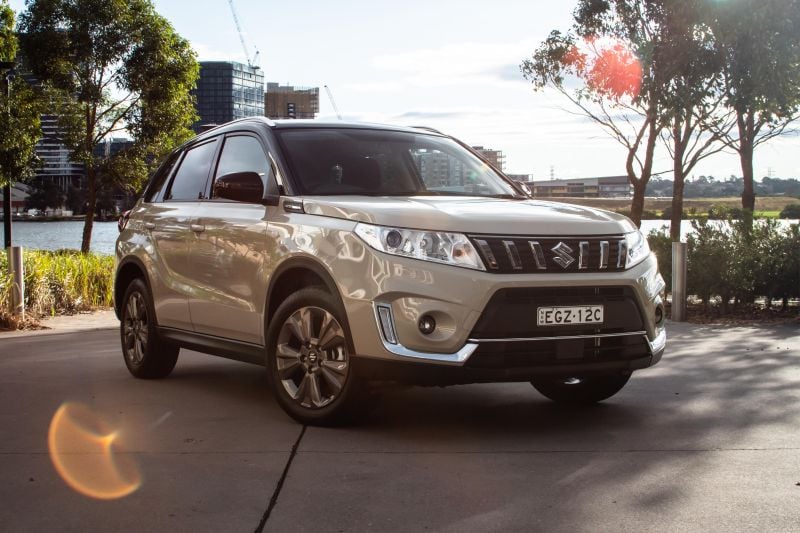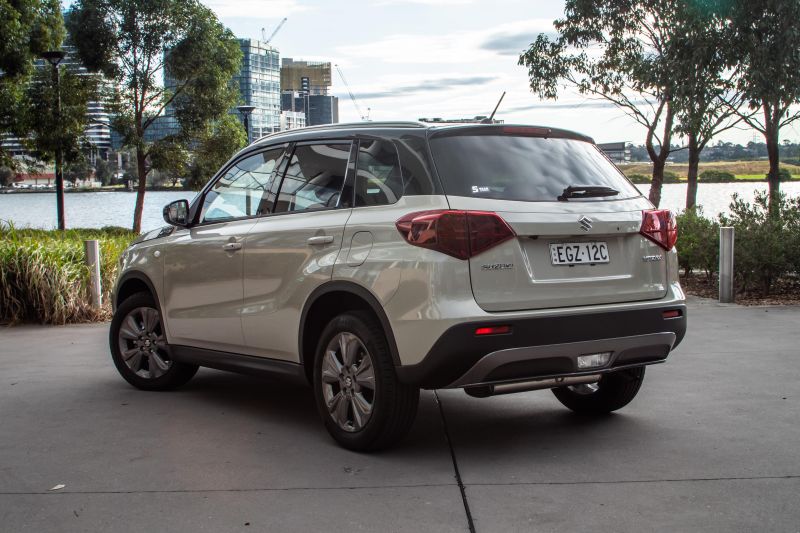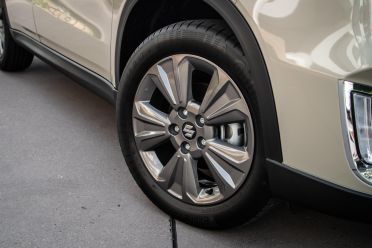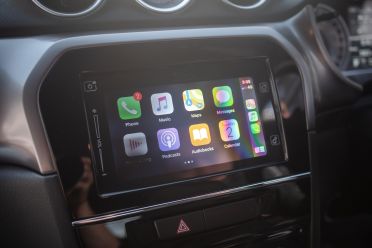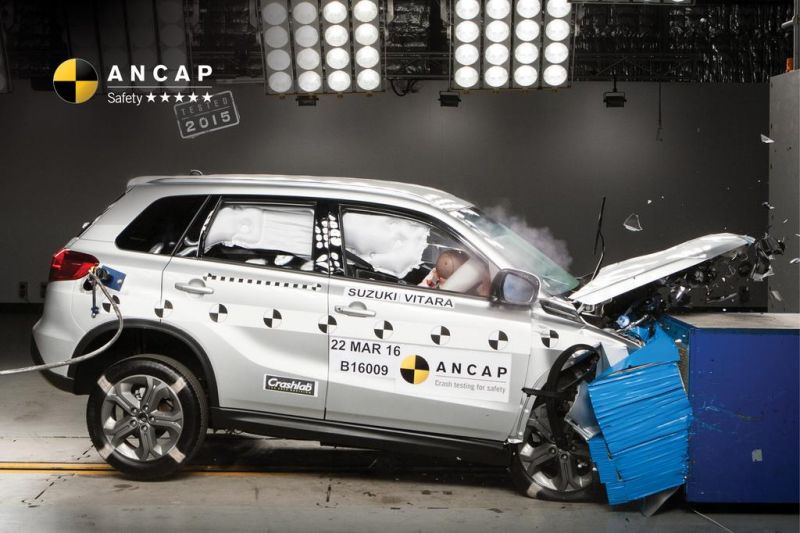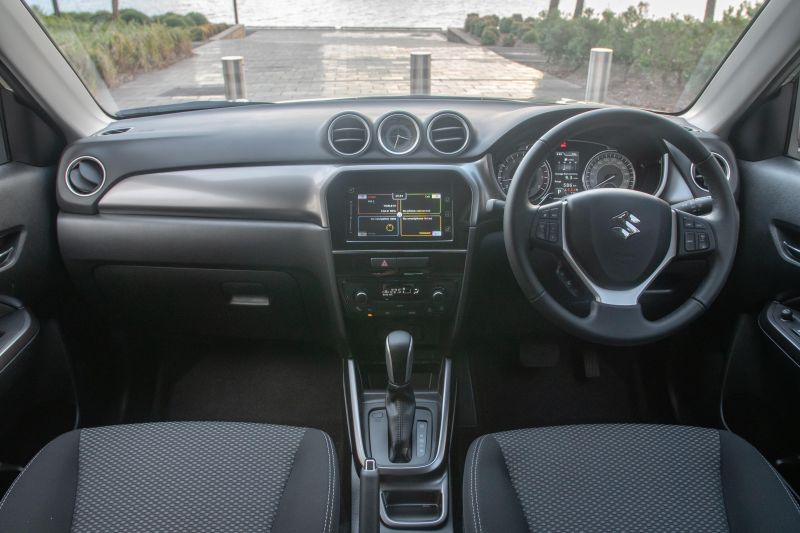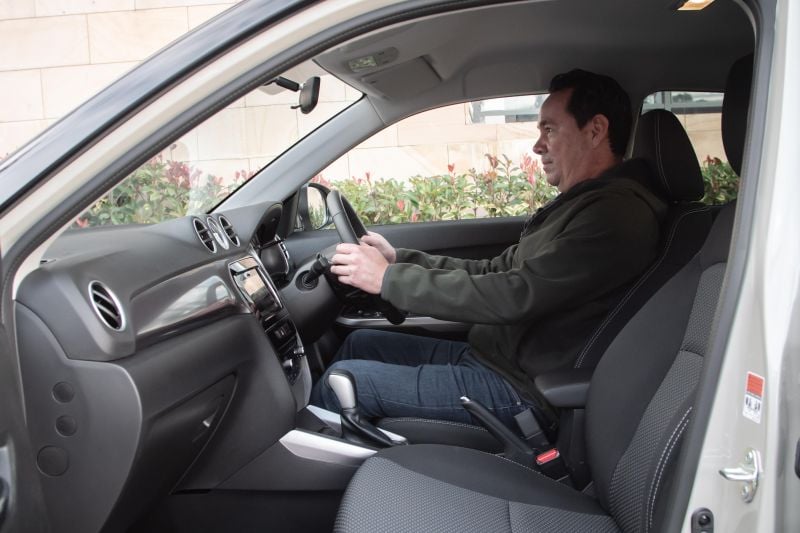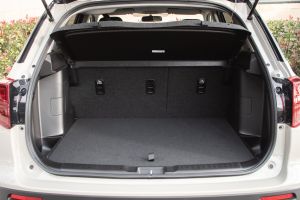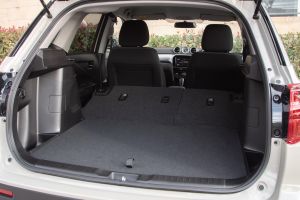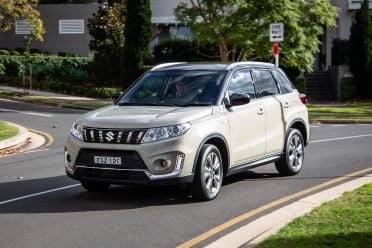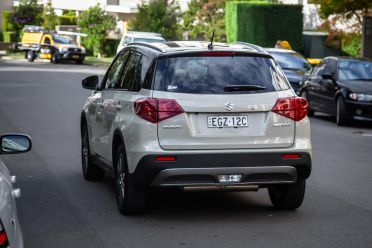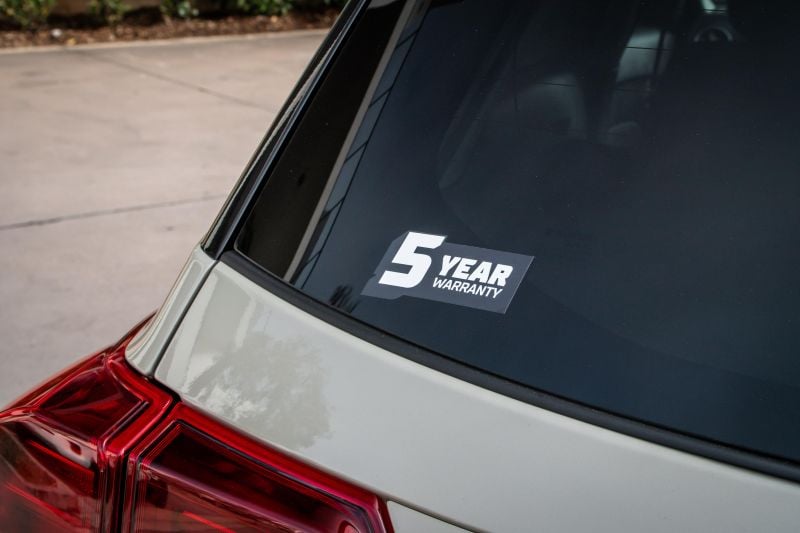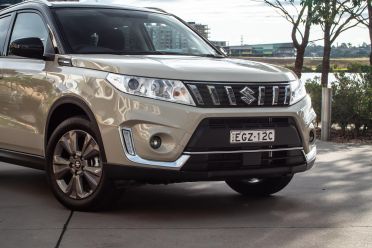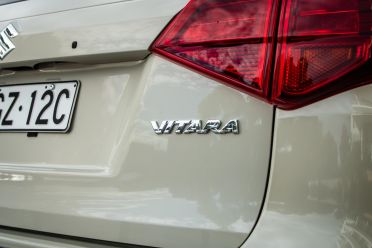The Suzuki Vitara is like a woodman doing a plie. That’s ‘plie’, so ‘l’ before the ‘i’. And before you aim your crosshairs at the messenger, they’re Suzuki’s words, not mine.
A “lumberjack doing ballet” sort of design, it states. Perhaps, if you squint really hard. What’s somewhat clearer to see is that the Japanese marque’s long-running nameplate aims to pitch a deft blend of style, price and substance into the small-SUV segment where such virtues are now expected.
With a half-decade of Aussie terra firma under the current generation’s tyres, 2019’s Series II facelift brought a light cosmetic makeover and a boost in active safety fit for the time, if exclusively to the mid-range Turbo and flagship all-paw Turbo AllGrip versions.
The tester here, though, is the regular Vitara, which its maker’s naming convention suggests is front-wheel drive and naturally aspirated.
It’s a price-buster, too, entering the SUV fray at $22,490 before on-roads in manual form and at the shallow end of the outlay pool, where it competes directly against modest versions of Kia Seltos, Hyundai Kona, MG ZS and Haval H2 in popular, as-tested auto form.
So does the stalwart nameplate have enough of that crucial substance part of the equation amongst many smart-looking, budget-savvy newcomers?

How much does the Suzuki Vitara cost?
Our auto-equipped base Suzuki Vitara lists for $24,490 before on-roads. At the time of writing, Suzuki has it at more seductive $24,990 drive-away offer – no pricier on road than the manual, in fact – the caveat being the offer is for 2019-plated examples only. Be quick, not fussy.
Nice paint, though, isn’t cheap. Like Japanese contemporaries Honda, Suzuki has a sharp eye for a good palette, with the two premium ($695) and five two-tone premium ($1295) paint schemes outside of no-cost white. Ours is in fetching if pricey two-tone Savannah Ivory with Cosmic Black roof.
For the curious, there’s $5500 step-up to the 1.4-litre BoosterJet-powered Suzuki Vitara Turbo ($29,990 list) and a further $4000 to add all-wheel drive and the full bells and whistles treatment ($33,990 list).
What do you get?
The Suzuki Vitara auto gets a solid if surprise-free level of specification for its mid-twenties price point.
The 17-inch alloys – as sized across the range – are a nice inclusion, and the base Vitara shares a leather wheel, 7.0-inch touchscreen infotainment, Apple CarPlay and Android Auto mirroring, cruise control, power windows, remote entry, keyless go and temperature regulating climate control with higher-grade variants. Proprietary sat-nav at this end of the range is a nice though not an essential inclusion.
Elsewhere, the rudimentary fit-out includes halogen headlights, cloth trim, electric mirrors and reversing camera, this entry variant missing out on niceties such as LEDs, leather and parking sensors, while wipers and exterior lighting are all fully manual control. You do, though, get a space saver spare and a nice large analogue clock, something of a time-honoured premium touch in its native Japan (even if it’s built in Hungary).
So no glaring spec omissions and enough feel-nice stuff in crucial areas. That is, if you discount active safety…
Is the Suzuki Vitara safe?
I’ve driven a slew of Suzukis recently and there’s a constant theme: if wide-ranging active safety and driver assistance is important to you then it’ll cost you. And $25,000-ish isn’t nearly enough for much of it at all in the regular Vitara.
The base variant doesn’t fit autonomous emergency braking. It’s not even available as an option.
Unsurprisingly, vehicles bereft of AEB usual omit many other contemporary safety nets. So you don’t get lane-departure warning, weave alert, blind-spot monitoring or rear cross-traffic alert… all of which were fitted to the pricer Turbo variants in 2019’s update.
What you do get is seven airbags – front, size curtain and driver’s knee – and ABS and stability control as minimum requirements.
Sure, it presents as a five-star ANCAP proposition – tested way back in 2015, updated in 2019 in sympathy of Series II updates – but the absence of safety nets in the base Suzuki Vitara should be taken into serious consideration for first car or family hauler consideration, both of which are right in this vehicle’s wheel house.
What is the Suzuki Vitara like on the inside?
The Vitara is neat in cabin presentation and a little more upmarket than some other Suzuki models. On feel-good vibe, it’s reasonably solid.
Apart from the overly shiny hard-plastic door trims it’s not overtly cost conscious, with a fair variety of colours and textures – satin grey inserts, piano black central stack garnish – and a neat multi-function wheel, Benz-like analogue instrumentation and a clear 4.2-inch colour driver’s screen that somehow misses a key trick in its lack of digital speedo. The large, old-school clock will please some buyers.
The 7.0-inch touchscreen infotainment is a familiar unit found elsewhere in the Suzuki stable, with simple and pleasing appearance if with somewhat mixed functionality. Apple CarPlay works a treat but it often takes ages to reconnect. It’s a little more intuitive to use than some competitor systems and makes for a pleasing centrepiece, though the jury is on the quality of the proprietary sat-nav as no SD card was installed.
Up front, the seats have a pleasing fabric texture, are nicely bolstered if firmed padded and there’s decent room and an airy ambience. Large bottle holders in the doors, dual cup holders, since 12-volt and USB outlets are all expected inclusions.
Row two, though, lets the team down. It’s quite cramped and, in roominess terms, it’s only really headroom that offers much breathing space. At under 180cm I’m not a big bloke, but I found it plenty cosy. It’s feasibly a four-adult prospect at best and only for short trips as row two lacks all creature comforts bar bottle holders in the doors: no air vents, no device power, not even a fold-down central arm rest.
That’s far from ideal for a family-oriented device.
Boot space is reasonable 375 litres that converts to modest 710 litres with the 60:40 rear split-fold seating stowed, though there is a dual-layer floor some buyers might find handy: high for easy load-in, low for extra space. The space saver spare is stowed under the ‘second floor’ and you get a handy 12-volt outlet.
All in all, the interior plays a stronger hand as a lifestyle runabout than a bona-fide SUV, which will certain favour some buyers types more than others.
What’s under the bonnet?
The entry-level, non-turbo Suzuki Vitara fits a 1.6-litre petrol four good for 86kW at 6000rpm and 156Nm way up at 4000rpm. While it comes up short in outputs against the boosted 1.4L (103kW/220Nm) in the turbo versions, it has more cubic capacity and shove than the naturally-aspirated 1.4s and 1.5s used elsewhere in the Suzuki range and feels more willing than the Baleno and Jimny I drove recently.
Mated to a conventional six-speed auto, the front-driven powertrain boasts an impressive 6.0L/100km combined consumption claim and happily runs on 91RON.
Oftentimes, working small and modestly powered engines to keep them on boil dramatically impacts real-world thirst, but our tester faithfully and impressively returned mid-sevens during what was mostly around town assessment.
How does the Suzuki Vitara drive?
Performance wise, the naturally-aspirated Vitara gets away with what it’s got. By that, I mean that there’s just enough torque to make for acceptably dignified and reasonably refined progress at a cruise or on the open road and it only feels raucous and strained when you want to get a move on accelerating or overtaking.
Burying the right foot off the mark is not a pleasant experience, though it’s not terribly tardy once a racket begins. It’s decent enough for most buyers wants and whims, then. It’s pretty quiet when it comes to road and tyre noise, though, so it’s pretty relaxing on long trips.
The six-speed is cooperative enough in D (for drive) though M (for manual) is quite handy for riding the engine’s four-grand torque peak up hills or for engine braking on steep descents. Thus set, it will upshift on its own accord when accelerating, though given it’s not pretending to be a sports car that’s no big foul. It is, though, easy to inadvertently select M when you were hoping for D shifting out of (P)ark or (R)everse…
Makes Do
Despite the base Vitara's relatively meek outputs it still offers a pleasant drive experience
Ride quality is quite resolved: not too soft nor firm, the latter an annoying trait plaguing some small SUV rivals. It’s neither overly sporty or disconcertedly flaccid to a strength, though the driving experience is impacted by the same slightly ‘sticky’ steering found in Baleno, with not quite enough free play and self-centring, leading to constant small steering corrections that becomes a bit tiresome.
At just 1180kg kerb, it’s quite featherweight by modest SUV measures and this translates directly to its pleasingly lithe handling. While its torsion beam rear end isn’t the most sophisticated engineering solution, it more than compensates with quality ride and handling balance that asserts itself on crook Aussie roads quite well. Better yet, it’s not encumbered by that dull ponderousness some small SUVs seem to embrace.
It feels compact, agile and easy to fling around the urban confines, with generous visibility and a clear sense of its outer dimensions, which is thankful given the lack of parking sensors. The reversing camera is grainy and wide-angled, but nevertheless does its job effectively enough.
How much does the Suzuki Vitara cost to run?
Suzuki’s decent five-year, unlimited-kilometre warranty and 12-month/15,000 kilometre maintenance intervals are par for the mainstream motoring course. That said, the mileage limit between services for the naturally-aspirated Vitara is more favourable than the 10,000km requirement for the turbo versions.
Servicing is price capped and averages out to $313 per year over the five-year/75,000km schedule.
As mentioned above, it runs happily on regular 91RON fuel.
CarExpert’s take on the Suzuki Vitara
The wood-chopping ballerina is also probably the most grown-up model in Suzuki’s fold. And its blend of smart presentation and substance at its price point will entice many buyers.
It does, however, fall short in key critical areas. Its packaging and features, particularly in second-row accommodation, are light on for its small SUV segment. In fact, it’s functionally happier as an urban crossover for ‘dinks’ than it is fit for family service.
Further, the lack of active safety in the base Suzuki Vitara impacts its SUV credentials to a point that for the business of hauling loved ones you really should find the extra coin for the more lavishly equipped turbo variants… if you can find that extra $5500, which will be too much of stretch for many buyer budgets.
It’s a shame you can’t divert that $1295 premium outlay for the fancy two-toned paintwork into some sort of safety option pack that would significantly boost Vitara’s suitability as a cheapy family runabout or ‘my first car’.

